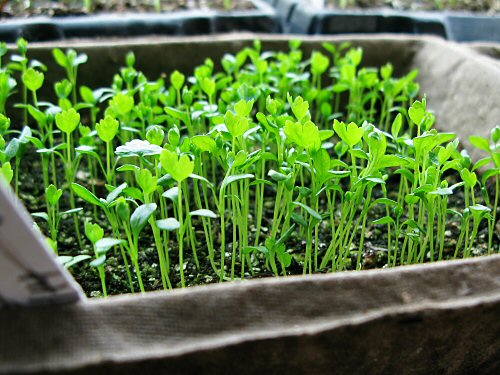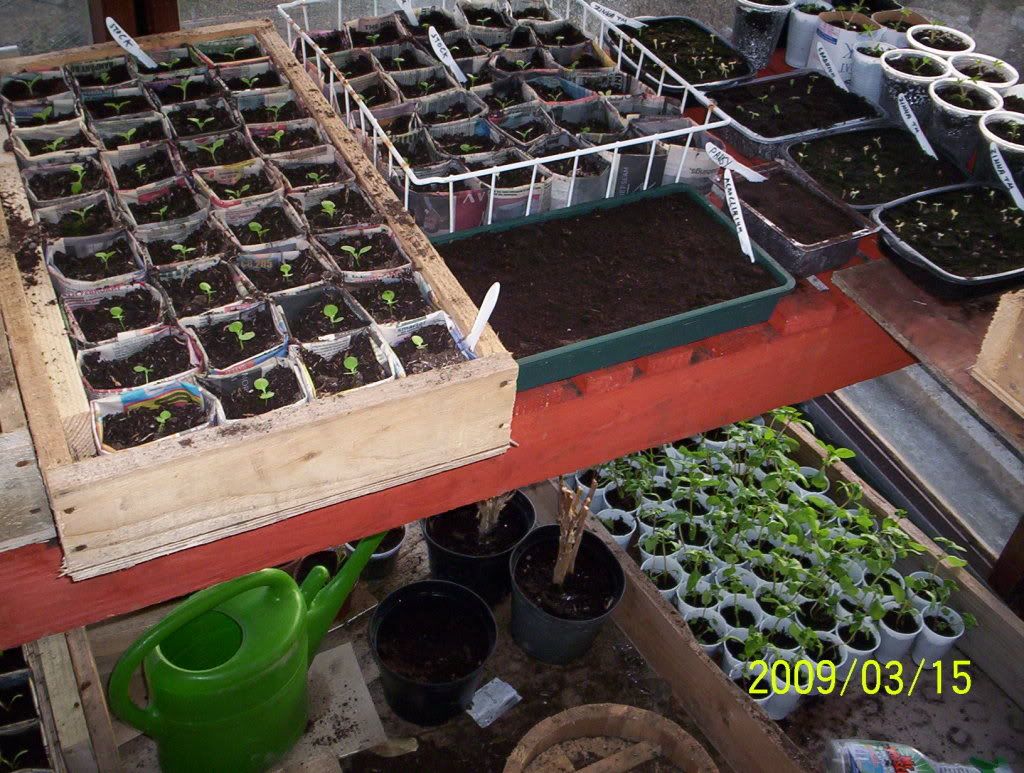

Seedling Care and Nurturing:
As your seedling emerges from the soil, most growers breath a big sigh of relief. Close your eyes and you can almost see the plant grow and flourish into it's full beauty, producing an enviable profusion of flowers or vegetables. As you open your eyes, you will immediately begin a new set of worries, over-nurturing the newborn indoors for a short time while the outdoor weather catches up with your dreams.
Thin Seedlings as needed- - Plants in your garden do not like to be crowded. Ditto with your seedlings, who need all the sun and nutrients that they can get.You may want to leave a few extras for a while as mortality rate of seedlings can be high.
Let there be light, and plenty of it- - As soon as the newborn seedling begins to emerge, it seeks light. Your newborn needs as much and as direct a light source as possible. Placing it by a window with a southern exposure is the first step. But this alone may not prove to be enough for the seedling to grow healthy and strong. First, the sun is not up as long in the spring as it is in the summer. Second, there are many rainy spring days with little or no direct sun. You should also acquire an artificial Grow Light and place the seedlings under it on cloudy days and at night.
Let There be Water, in just the right amount- - Provide water to your seedling every couple of days. Do not soak the soil each night. Overly wet soil encourages the development of damping off disease. Let the soil dry out a little on the top, then water thoroughly. Watering from the bottom is preferred. If you have a seed tray, add water to the bottom of the tray . The soil will absorb it through the bottom holes in your container...your container does have holes in the bottom, doesn't it!?!
Feed me, feed me- - The seedling does not need a lot of extra nutrients in it's first few days of life. Your soil starting mix usually comes with a balanced formula of nutrients that the seedlings need. After several days, adding a little liquid fertilizer to the water is helpful, but you do not need to give it full strength.
If the roots begin to come out the bottom of the pot, it is time to plant your seedling outdoors, weather permitting. If it is still too cool, keep the bottom of the tray moist, or put some extra soil in the bottom of the tray. Or, transplant seedlings to a larger pot. Most plants do not like to be root bound.
Guard against Leggy Plants- - Seedlings are leggy when their main stem or stalk grows tall and thin and can hardly support the leaf structure. It is caused by insufficient sunlight and a sheltered environment. Indoors, they do not experience the effect of wind, and do not need to develop structure to defend against it. Most seedlings do not even experience a slight breeze. When transplanted outdoors, "leggy" plants can be damaged or broken by the wind.
Tip: Take your hand,or a couple sheets of newspaper and fan the plants a few times a day. You can even lightly brush the tops of the plants, brushing back and forth in varying directions. You may notice the plants seem to slow down for a period. What they are really doing is building a stronger stem or stalk.
Let there be no Damping Off Disease:
Those of us who have grown seedling indoors for any number of years know what "Damping Off" disease. This is a white mold that forms in the top of the soil. Damping Off disease flourishes in cold, wet damp weather along with little sunshine. It quickly spreads across the soil and wilts the seedling. Take it's habitat away, and the disease can not survive. Plants on the other hand, love just the opposite conditions. The more you make conditions ideal for your plants, the more likely you will avoid Damping Off Disease and other mold and fungal problems.
If you do experience problems, do not give up hope. Here are some things you can do to minimize or eliminate disease problems:
-
First, get the plant in direct sunlight if at all possible.
-
Stop watering until the surface is very dry.
-
Water only from the bottom.
-
Scrape as much of the mold off the soil as possible.
-
Stir the top of the soil without disturbing the roots. It will also speed drying.
-
Add some soil, although this may or may not produce results.
-
Increase room air circulation. You can gently blow air on your plant trays with a small fan.
No comments:
Post a Comment